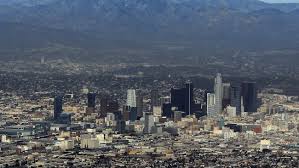4.7 earthquake in Southern California
A modest earthquake left Southern California with the jitters Monday but no serious damage as the temblor caused swaying and rolling from the desert to the coast, sending children scrambling under their desks and office workers running for the door.
The 9:55 a.m. quake had an estimated magnitude of 4,7, said Nick Scheckel, seismic analyst at the California Institute of Technology’s seismological laboratory in Pasadena.
The epicenter was about a dozen miles from the Riverside County desert community of Anza, about 100 miles southeast of Los Angeles, and it was felt strongly at the BNP Paribas Open tennis tournament happening in nearby Indian Wells.
The temblor, which occurred at a depth of eight miles, caused a swaying or rolling motion in Los Angeles and San Diego as well as in Orange and San Bernardino counties. It was sandwiched between several foreshocks and aftershocks.
“It kind of shook and then I thought, `God, is that an earthquake?’” said Susie Bride – a cashier at Cahuilla Mountain Market and Cafe in Anza. “It kind of shook and then it rolled a little bit and then it shook again.”
Monday morning’s magnitude 4,7 earthquake in Riverside County was the largest temblor to hit the Los Angeles region in three years and has produced more than 100 aftershocks.
It caused no major damage, but it was felt over what seismologists said was an unusually large area.
The quake was initially recorded as three separate temblors because a foreshock tricked seismograms into recording multiple quakes of multiple sizes, said Susan Hough, a USGS seismologist.
Earthquakes of a 4,7 magnitude are typically felt only about 120 miles away from the epicenter, but Monday morning’s quake traveled farther, shaking coffee cups as far as Los Angeles.
That’s because the quake occurred in the San Jacinto Mountains, which are composed of hard granite that transmits energy more efficiently, Hough said.
The quake occurred along the San Jacinto fault zone, which runs through San Bernardino, Riverside, San Diego and Imperial County roughly parallel to the San Andreas fault. It’s one of three fault zones that absorb friction from the motion of the North American continent and the Pacific plates rubbing against each other.
“It’s capable of generating moderate to large earthquakes” – said USGS seismologist Robert Graves. “Today’s activity was not out of the ordinary. Actually, it’s pretty typical of the area.”
A magnitude 4,7 earthquake struck deep beneath a mountain range in Southern California on Monday, jangling the nerves of tennis stars competing in the nearby desert town of Indian Wells and rattling urban areas as far away as Los Angeles, but no damage or injuries were reported.
Automated sensors initially reported the quake as a flurry of three tremors in rapid succession at magnitudes of 5,1 or higher, but seismic strength was quickly downgraded to between 4,6 and 4,7 before scientists determined that only a single quake of that size had actually occurred.
Susan Hough, a seismologist for the U.S. Geological Survey in Pasadena, said the agency’s real-time quake-reporting system was “confused” by a 2,3 magnitude foreshock that preceded the main jolt by 16 seconds, and a 3,2 aftershock less than a minute later.
The main quake, which hit shortly before 10 a.m. local time about 22 miles (35 km) south of the resort town of Palm Springs, ended up being followed by about 100 very small aftershocks, she said.
The principal tremor occurred about 6 to 8 miles (12 to 14 km) beneath the San Jacinto Mountains, a granite range towering over California’s southern desert, on a branch of an active fault line named for the mountain, Hough said.
Quakes of similar size typically generate too little ground motion to cause any property damage.
“If you were sitting right on top of a 4,7, it might have knocked some things off the wall” – she told Reuters, but centered in the mountains as it was: “we’d expect little or no damage.” None was reported, she said.
